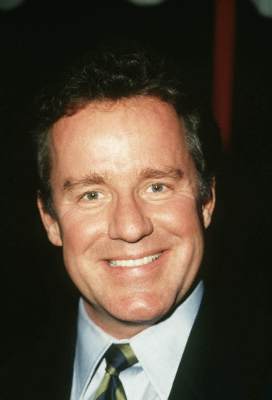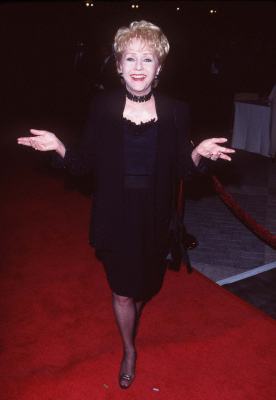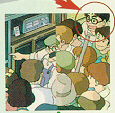
Cast * Interesting Facts * Production Details * Main Source for this Page: Nausicaa.Net

Cast * Interesting Facts * Production Details * Main Source for this Page: Nausicaa.Net
Original Title: Majo no Takkyuubin
 Directed
by: Hayao Miyazaki
Directed
by: Hayao Miyazaki
Written by: Eiko Kadono & Hayao Miyazaki,
Jack Fletcher (U.S. version)
Music by: Joe Hisaishi, Sydney
Forest (U.S.)
Production Period: April 1, 1988 - July 17, 1989
Released on: July 29, 1989 (Japan theatrical
release); September 1, 1998 (U.S. video premiere)
Running Time: 103 minutes
Budget: ¥800 million (initial
plan)
Box-Office: 2,640,619 admissions and ¥2.17
billion in film rental
 |
 |
 |
 |
 |
Kiki... Kirsten Dunst (Interview With A Vampire)
Ursula... Janeane Garofalo (The Truth About Cats and Dogs)
Jiji... Phil Hartman (Saturday Night Live, The Simpsons)
Tombo... Matthew Lawrence (Mrs. Doubtfire, brother of
Joey Lawrence)
Madame (nice old lady)... Debbie Reynolds (Singing In The
Rain)
![]() In the Japanese
version, Minami Takayama did the voice of Kiki. Amazingly, she also did
the voice of Ursula. Ursula is a grown-up Kiki, who now knows her way and
is a bit more sure of herself. Takayama Minami also did the voice of Kousaka
Sensei, the health room teacher at Shizuku's school in "Mimi".
In the Japanese
version, Minami Takayama did the voice of Kiki. Amazingly, she also did
the voice of Ursula. Ursula is a grown-up Kiki, who now knows her way and
is a bit more sure of herself. Takayama Minami also did the voice of Kousaka
Sensei, the health room teacher at Shizuku's school in "Mimi".
![]() The English version
of Kiki's Delivery Service was dedicated to Phil Hartman (1948-1998)
who died tragically shortly after wrapping up his voice-over work.
On May 28, 1998, he was shot to death while asleep in his bed by his wife,
Brynn. She then killed herself shortly after the police arrived at their
Encino home.
The English version
of Kiki's Delivery Service was dedicated to Phil Hartman (1948-1998)
who died tragically shortly after wrapping up his voice-over work.
On May 28, 1998, he was shot to death while asleep in his bed by his wife,
Brynn. She then killed herself shortly after the police arrived at their
Encino home.
![]()
 In
the scene in Kiki's bedroom where she says good-bye to her father, there
is a small toy house in her bookshelf. Mei and Chibi-totoro are painted
into the windows. Also, there is a stuffed animal that looks somewhat like
Totoro on her bed. In the scene where Kiki was almost hit by a bus when
she first came to Koriko, "Studio Ghibli" is written on the side of the
bus. The "Ghibli bus" also passes behind Kiki while she is questioned by
a policeman. In the scene at the end where the street-sweeper is pointing
at the TV and saying "that's my broom she used", Miyazaki is in the upper-right
corner of the picture looking on.
In
the scene in Kiki's bedroom where she says good-bye to her father, there
is a small toy house in her bookshelf. Mei and Chibi-totoro are painted
into the windows. Also, there is a stuffed animal that looks somewhat like
Totoro on her bed. In the scene where Kiki was almost hit by a bus when
she first came to Koriko, "Studio Ghibli" is written on the side of the
bus. The "Ghibli bus" also passes behind Kiki while she is questioned by
a policeman. In the scene at the end where the street-sweeper is pointing
at the TV and saying "that's my broom she used", Miyazaki is in the upper-right
corner of the picture looking on.
![]() The denouement
scenes of the film play out with the credits rolling ending with Kiki's
parents reading a letter from her after the credits finish.
The denouement
scenes of the film play out with the credits rolling ending with Kiki's
parents reading a letter from her after the credits finish.
![]() In the English
translation by Disney, there is a line added at the end of the film that
suggests that Jiji might be able to speak to Kiki again after losing that
ability in the film.
In the English
translation by Disney, there is a line added at the end of the film that
suggests that Jiji might be able to speak to Kiki again after losing that
ability in the film.
![]()
 Kiki's
town, Koriko, is "a mishmash of various locales, like Napoli, Lisbon, Stockholm,
Paris, and even San Francisco. Therefore, one side is like the shores of
the Mediterranean sea, but another side seems to border on the Baltic sea."
Miyazaki and his main staff visited Visby on the Swedish island of Gotland,
and they also visited Stockholm. They shot 80 rolls of film in Stockholm
and Visby, gathering location images as inspiration for the scenes in Koriko.
For the most part, Koriko is composed of images of Stockholm. A side street
in Stockholm's old city, Gamla Stan, is one model. Sweden was the
first foreign country Miyazaki ever visited. It was for the Pippi Longstockings
project, back in the 1970s. The trip didn't achieve its purpose (getting
permission from the author of "Pippi"), but Visby apparently left a strong
impression on him, so he later used its images in Kiki.
Kiki's
town, Koriko, is "a mishmash of various locales, like Napoli, Lisbon, Stockholm,
Paris, and even San Francisco. Therefore, one side is like the shores of
the Mediterranean sea, but another side seems to border on the Baltic sea."
Miyazaki and his main staff visited Visby on the Swedish island of Gotland,
and they also visited Stockholm. They shot 80 rolls of film in Stockholm
and Visby, gathering location images as inspiration for the scenes in Koriko.
For the most part, Koriko is composed of images of Stockholm. A side street
in Stockholm's old city, Gamla Stan, is one model. Sweden was the
first foreign country Miyazaki ever visited. It was for the Pippi Longstockings
project, back in the 1970s. The trip didn't achieve its purpose (getting
permission from the author of "Pippi"), but Visby apparently left a strong
impression on him, so he later used its images in Kiki.

![]() In the Japanese version, the opening song, "Rouge no Dengon (Message in
Rouge)" and the ending song, "Yasashisa ni Tsutsumareta Nara (If I've Been
Enveloped by Tenderness)" are actually old songs from the 70s, written
and sung by Yumi Matsutoya. Yuming, as she is usually called, has been
one of the most popular female singer/songwriters in Japan. In the
Disney dub, the opening song "Soaring" and the ending song "I'm Gonna Fly"
are written and performed by Sydney Forest.
In the Japanese version, the opening song, "Rouge no Dengon (Message in
Rouge)" and the ending song, "Yasashisa ni Tsutsumareta Nara (If I've Been
Enveloped by Tenderness)" are actually old songs from the 70s, written
and sung by Yumi Matsutoya. Yuming, as she is usually called, has been
one of the most popular female singer/songwriters in Japan. In the
Disney dub, the opening song "Soaring" and the ending song "I'm Gonna Fly"
are written and performed by Sydney Forest.
Miyazaki was not supposed to direct Kiki. At first, Miyazaki was going to just produce the movie, since it was supposed to be a project for Ghibli's younger staff members. However, Miyazaki didn't like the script a young scriptwriter wrote, so he wrote it himself (at first, he thought about using a pen-name, "Oaza Takesato", which can be read "O Ghibli") . Then, the young director got intimidated, so Miyazaki ended up directing it himself.
 The
film is based on a children's book, "Majo no Takkyuubin", by Eiko Kadano.
Ms. Kadono was not particularly happy with the changes Miyazaki made. The
book is episodic, consisting of small stories about people and incidents
Kiki encounters while delivering things. Nothing really bad or dramatic
happens to Kiki. She never loses her powers, and there is no blimp accident
in the book. Miyazaki made these changes since he needed a story that would
hold up a film, and he wanted to tell a story about the process of growing
up. Miyazaki writes, "As movies always create a more realistic feeling,
Kiki will suffer stronger setbacks and loneliness than in the original."
Only after overcoming such setbacks and loneliness could she grow up."
It is said that Ms. Kadono was so unhappy with these changes that the project
was almost scrapped at the screenplay stage. Miyazaki and Suzuki, the producer
of Ghibli, went to Ms. Kadono's house, then invited her to the studio,
and finally persuaded her to give her consent to the movie.
The
film is based on a children's book, "Majo no Takkyuubin", by Eiko Kadano.
Ms. Kadono was not particularly happy with the changes Miyazaki made. The
book is episodic, consisting of small stories about people and incidents
Kiki encounters while delivering things. Nothing really bad or dramatic
happens to Kiki. She never loses her powers, and there is no blimp accident
in the book. Miyazaki made these changes since he needed a story that would
hold up a film, and he wanted to tell a story about the process of growing
up. Miyazaki writes, "As movies always create a more realistic feeling,
Kiki will suffer stronger setbacks and loneliness than in the original."
Only after overcoming such setbacks and loneliness could she grow up."
It is said that Ms. Kadono was so unhappy with these changes that the project
was almost scrapped at the screenplay stage. Miyazaki and Suzuki, the producer
of Ghibli, went to Ms. Kadono's house, then invited her to the studio,
and finally persuaded her to give her consent to the movie.
You might notice that there are bells put on the trees near Kiki's home: it was the only wish of Ms. Kadono, that these bells be rung when Kiki leaves her hometown. In the book, it was explained that Kiki's mom put bells on the top of every tall tree in town. The reason for this was that Kiki would sometimes get lost in thought and start to lose altitude without noticing. The bells went up after she had a head-on collision with a telephone pole, totalling her broom and bruising herself.
 The
film's original title, Majo no takkyubin,
literally means "Witch's Delivery Service". "Takkyuubin" is actually
a word created by Yamato Unyu (Yamato Transport, Co., Ltd.) when they started
their new service, door-to-door home delivery. Yamato uses black cats (a
mother cat carrying a kitten in her mouth) as its trademark, and has a
catch phrase, "Black Cat Yamato's Takkyuubin". Yamato sponsored the movie,
though there was a controversy inside the company at first. Ms. Kadono,
the author of the original book, used the word "Takkyuubin", without permission
from Yamato, and they were unhappy about it. However, people loved the
movie, and it helped Yamato's company image, so everybody was happy in
the end.
The
film's original title, Majo no takkyubin,
literally means "Witch's Delivery Service". "Takkyuubin" is actually
a word created by Yamato Unyu (Yamato Transport, Co., Ltd.) when they started
their new service, door-to-door home delivery. Yamato uses black cats (a
mother cat carrying a kitten in her mouth) as its trademark, and has a
catch phrase, "Black Cat Yamato's Takkyuubin". Yamato sponsored the movie,
though there was a controversy inside the company at first. Ms. Kadono,
the author of the original book, used the word "Takkyuubin", without permission
from Yamato, and they were unhappy about it. However, people loved the
movie, and it helped Yamato's company image, so everybody was happy in
the end.
|
||||||||||||